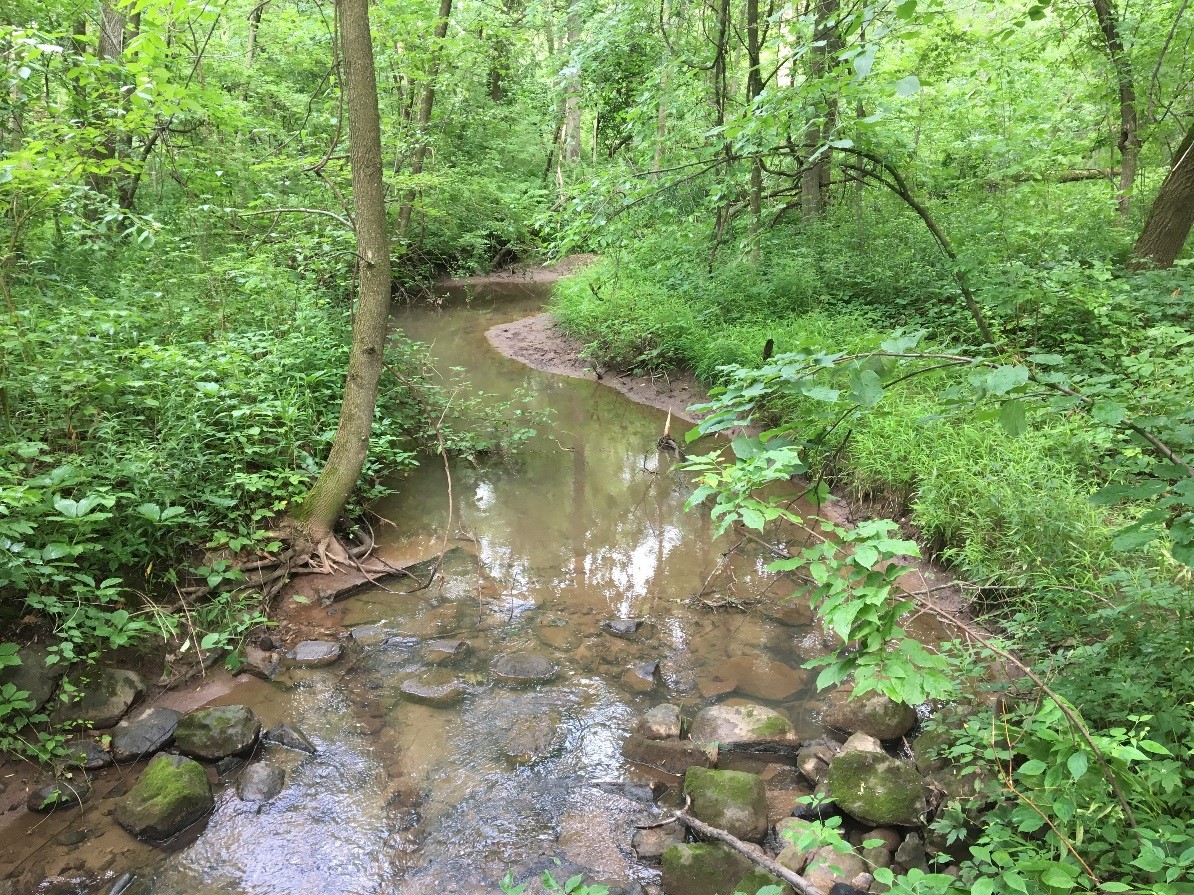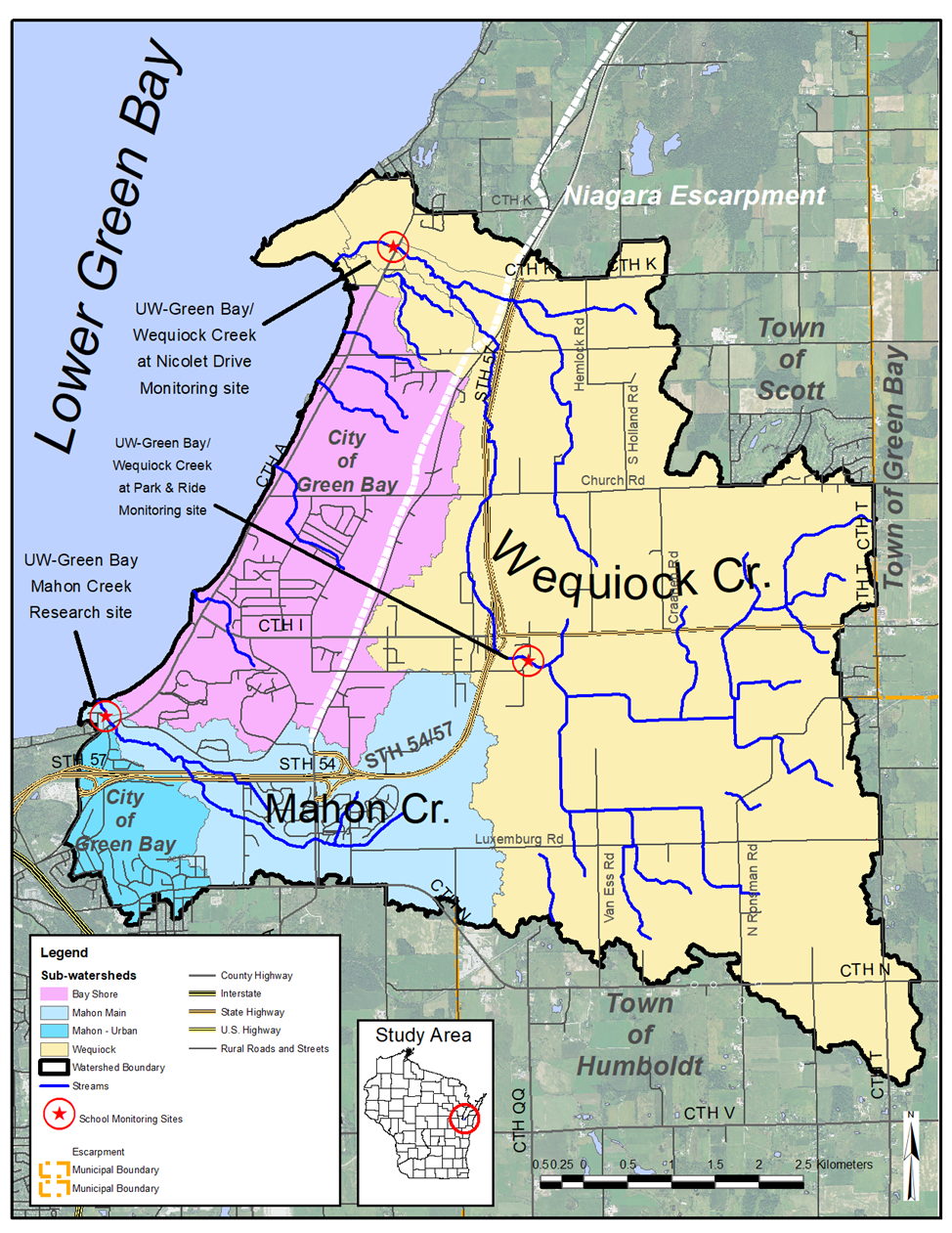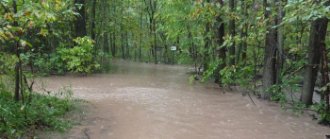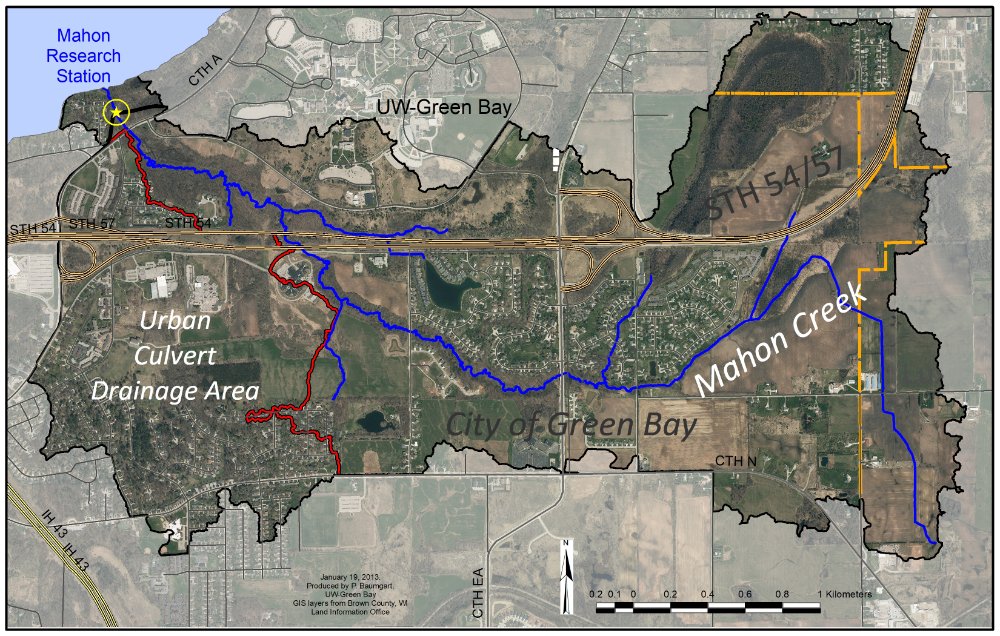Mahon Creek Water Monitoring Station
Overview
Mahon Creek originates south of Highway 57 and flows through farm fields and a housing development onto the UW-Green Bay campus where the stream flows through Mahon Woods and into the bay of Green Bay. The Mahon Creek watershed (3.71 mi2 or 9.60 km2) lies within the Lower East Shore watershed. The map below shows the boundary of the Mahon Creek watershed and the position of the UW-Green Bay water monitoring station, which has a drainage area of 2.79 mi2 or 7.23 km2. Land cover in the Mahon Creek watershed is composed of agriculture (38%) followed by urban (33.5%) and natural areas (28.5%) which primarily consists of wetland, forest, and grassland (see Figure and Table for more information). Soil infiltration capacity is generally low (pdf, png). Soil slope varies from shallow in the upper portion of the watershed, steep near the Niagara Escarpment, to very steep along the ravine adjacent to the main stem of Mahon creek (pdf, png).
A continuous automated monitoring system was needed to accurately characterize hydrology and water quality in the stream. A permanent station was installed in December of 2010 with the help of staff, students, and several generous donors. The shingled building that houses the sampling and electrical equipment was designed to blend in with the surrounding forest. Data collected at this station provide an important educational resource for students and is used to help manage water quality on the UW-Green Bay campus, Mahon Creek watershed and the bay of Green Bay. The station is maintained by Cofrin Center for Biodiviersity staff Bobbie Webster and Andrew Laplant, with help from volunteers.
Equipment and measurements
Stream height (stage) is monitored continuously in Mahon Creek about 750 feet upstream from the outlet to Green Bay, and in a nearby 6 foot urban stormwater culvert which merges with the creek 180 feet downstream from the monitoring station. Stream discharge (volume/time) is periodically measured manually with a handheld OTT acoustic digital current (ADC) meter or with a StreamPro acoustic velocity meter that is mounted on a small boat and towed across the stream during larger storm events that are difficult or impossible to measure instream. Stage is recorded at the same time as the flow measurement and the resulting stage-discharge relationship is combined with continuous stage data to calculate continuous stream discharge.
Rainfall or snow melt related runoff event samples are collected from Mahon Creek throughout an event with a refrigerated Teledyne ISCO automated sampler based on the rise and fall in stream height, or the amount of time between samples. Grab samples are collected monthly during non-event periods. Samples are analyzed in the UW-Green Bay chemistry laboratory for Total Phosphorus (TP), Dissolved Phosphorus (DP) and SSC (suspended sediment concentration) or a commercial certified lab such as NEW Water in Green Bay (TP, DP and Total Suspended Solids - TSS). A sufficient number of TP and SSC or TSS samples have been collected from Mahon creek for researchers to calculate daily loads with the USGS GCLAS software program when the concentration data are coupled with the continuous flow record.
Water temperature, pH, dissolved oxygen and conductivity were recorded continuously (2011 to 2016) during ice-free periods with Hydrolab multiparameter sondes located in Mahon creek and the culvert. Subsequent data are transmitted through direct cable connections to the Mahon Station. In July 2012 a Campbell Scientific OBS-500 turbidity probe was installed in the urban culvert which recorded turbidity at 5 minute intervals during runoff events, and less frequently at other times. This allowed UW-Green Bay researchers to establish a relationship between turbidity and SSC, particulate phosphorus and total phoshorus sample concentrations from the culvert which can be used to estimate concentrations and constituent loads on a continuous basis. A Campbell Scientific CR1000 programmable data logger records all data measurements. Remote access to the data logger is provided via a cell-phone modem, so all measured data, as well as station input variables like sampling parameters can be observed and adjusted real-time.
Reference to any specific commercial monitoring products or manufacturer does not imply its endorsement, recommendation or otherwise by UW-Green Bay.
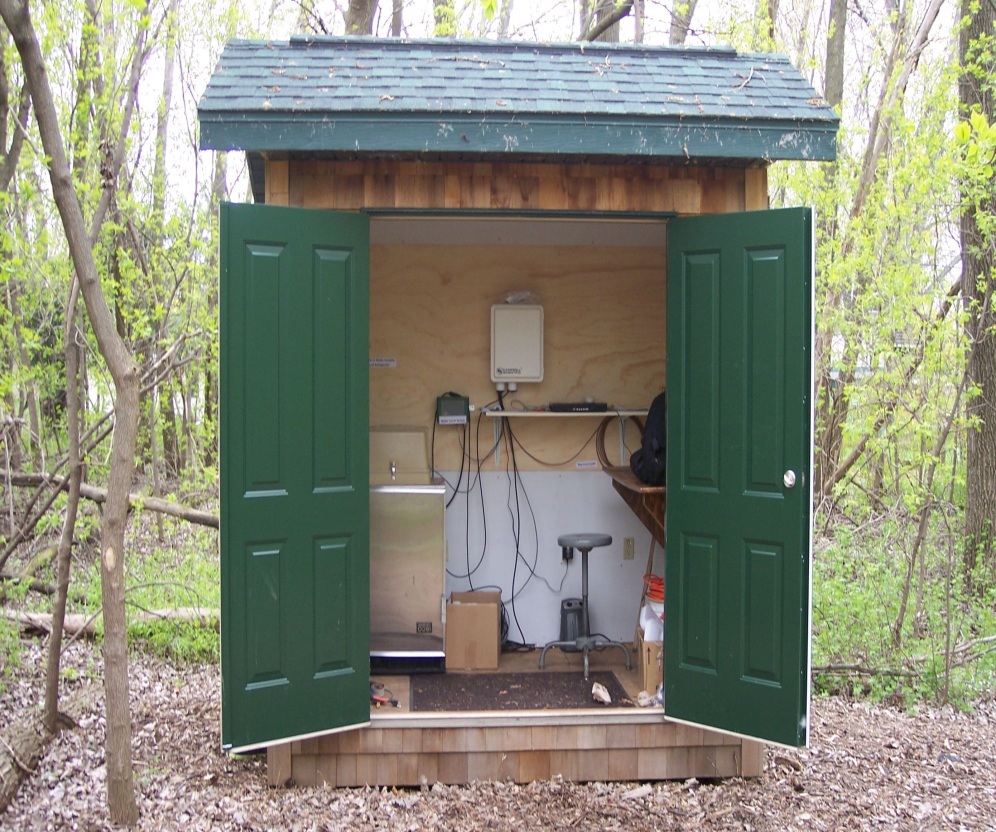
Water Quality Results
Concentrations of TSS, TP and DP (mg/L) in water samples collected from Mahon Creek are summarized in Table 1 for event, low flow, and combined sample categories. Over 800 samples have been analyzed thus far for TP and TSS, and 162 samples for DP. The mean concentration of TP for all samples was 0.32 mg/L, while the maximum concentration was very high (5.8 mg/L), with 65 samples of 0.9 mg/L or greater (7.6% of all samples). The mean concentration of TSS for all samples was 147 mg/L with a maximum of 3,520 mg/L. Median concentrations were 41 mg/L TSS, 0.156 mg/L TP and 0.048 mg/L DP for the entire sample set.
Table 1. Summary of water sample concentrations (mg/L) at UW-Green Bay Mahon Creek Research Station near outlet to Green Bay
| ALL samples | EVENT samples | LOW flow samples | |||||||||
|---|---|---|---|---|---|---|---|---|---|---|---|
| TP | DP | TSS | TP | DP | TSS | TP | DP | TSS | |||
| # of samples | 859 | 162 | 819 | 740 | 74 | 701 | 117 | 88 | 117 | ||
| Mean | 0.324 | 0.091 | 147 | 0.362 | 0.136 | 170 | 0.087 | 0.052 | 11 | ||
| Median | 0.156 | 0.048 | 41 | 0.195 | 0.081 | 58 | 0.062 | 0.038 | 6 | ||
| Max | 5.78 | 1.77 | 3520 | 5.78 | 1.77 | 3520 | 1.14 | 0.29 | 154 | ||
| #>0.5 mg/L | 136 | 2 | 135 | 2 | below: May-Oct only and with lower detection limits | ||||||
| #>0.9 mg/L | 65 | 2 | 64 | 2 | 14 | 14 | # samples | ||||
| #>2.0 mg/L | 19 | 19 | 0.125 | 0.095 | mean | ||||||
| #>3.0 mg/L | 7 | 7 | 0.11 | 0.072 | median | ||||||
The median TP concentration for Mahon Creek during the May to October 2019 period was 0.120 mg/L (n = 6), which exceeds the Wisconsin phosphorus criteria of 0.075 mg/L (Figure 1). The median DP concentration for the same period was 0.117 mg/L, indicating that most of the phosphorus is readily available for uptake by algae during low flow conditions. This period and statistic are consistent with the methodology used to establish the phosphorus criteria (Robertson et al, 2006, 2008); however, this methodology involved random sampling near mid-month, rather than only during non-event periods as was used in this project. If event data had been included in this project, the median concentrations may have increased. Only data collected from September 2018 onward were summarized for the May to October period in Table 1 and Figure 1 because we recently started utilizing a phosphorus analysis method with a lower detection limit at the certified lab where the samples were submitted for analysis. Figure 1 also compares low flow TP concentrations for two sites in nearby Wequiock creek.
The table below summarizes the calculated annual flow and loads of TP and TSS from Mahon Creek (not including the culvert) from 2011 to 2016. Annual flow in mm is based on the total annual stream flow volume divided by the watershed area, which makes it easier to compare to other watersheds (note: 200 mm is roughly 8 inches). High water levels in Lake Michigan and Green Bay prevented annual load calculations after 2016 because water from the bay backed up Mahon creek to beyond the station monitoring equipment during many events, particularly during strong northerly wind periods, thereby preventing accurate stage and flow measurements and causing bay water to mix with stream water.
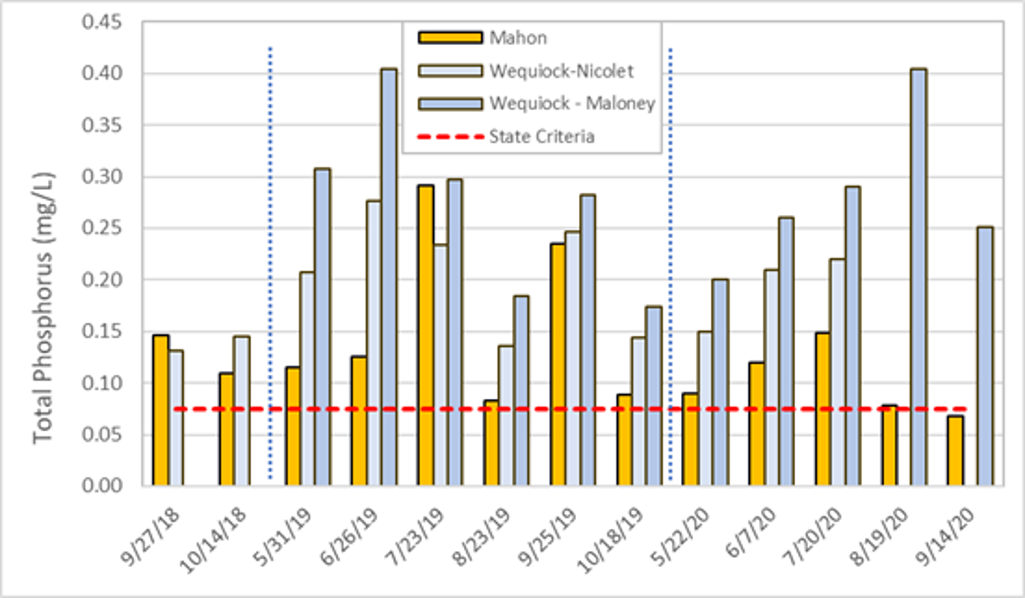
Figure 1. May to October total phosphorus concentrations under low flow conditions in Mahon Creek and nearby Wequiock Creek, relative to the Wisconsin water quality standard.
| Annual Loads | TP | TSS | Flow |
|---|---|---|---|
| (kg) | (Mg) | (mm) | |
| 2011 | 704 | 228 | 355 |
| 2012 | 179 | 88 | 188 |
| 2013 | 297 | 76 | 298 |
| 2014 | 363 | 139 | 319 |
| 2015 | 401 | 104 | 231 |
| 2016 | 401 | 126 | 375 |
Urban Culvert
Samples were also collected just below the outlet of the nearby 6-ft (1.8 m) urban culvert, which is adjacent to the UW-Green Bay research station. This culvert drains 0.873 mi2 (2.26 km2) of mostly urban area within the City of Green Bay and joins the main stem of Mahon Creek just downstream of the primary stream monitoring location. Sample results from the urban culvert summarized in the below table indicate that phosphorus concentrations from the culvert (n = 72) are similar, or slightly lower than samples collected from the adjacent main stem of Mahon Creek during low flow conditions.
| Mahon Research Station - Urban Culvert: water sample concentrations (mg/L). Only 3 events were sampled. | |||
|---|---|---|---|
| TP | DP | TSS | |
| # samples | 72 | 53 | 70 |
| mean | 0.084 | 0.052 | 17 |
| median | 0.040 | 0.035 | 2 |
| max | 1.03 | 0.60 | 932 |
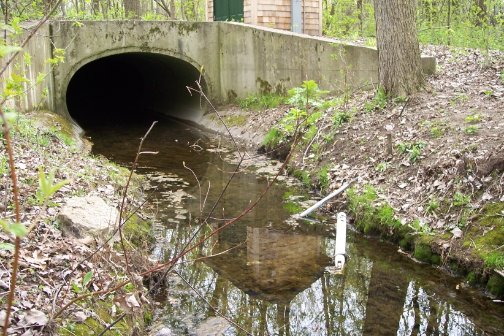
Comparisons to streams in other Lower Fox watersheds
Watershed yields (mass/water volume over time), flow-weighted concentrations and sample concentrations from Mahon creek are compared to other Lower Fox watershed streams in the following list of links to tables, plots and charts. Water quality in Mahon creek was better than most Lower Fox watershed streams with regards to concentrations and area-weighted loads (yields) of TSS and total phosphorus.
- Annual Yields of discharge, TSS, total and dissolved phosphorus (Tables | Charts without Wequiock, Ash-Grant, Dutchman)
- Annual Flow-Weighted Concentrations of TSS, total and dissolved phosphorus (Tables | Plots)
- Sample Concentrations (Box Plots | Tables) under Low, Event and All Flow conditions (excluding Wequiock creek)
- See AGL Water Monitoring Coordination Report-Appendix A for more details and analysis
- Locations of Lower Fox River Watershed Monitoring Program (LFRWMP) stations and USGS stations (Map | Map with links)
Additional Data Sources
- WDNR monitoring station data (Nicolet, upstream, near L. Largo);
- WDNR GIS Surface Water Data Viewer (SWDV) with links to WDNR monitoring station data
We would like to thank the following generous donors for contributing funds, equipment, materials, expertise and labor toward the construction and operation of the Mahon Creek Station:
- Cofrin Center for Biodiversity
- 1923 Fund (primary donor)
- Van's Lumber & Custom Builders (materials and labor)
- Wisconsin Public Service Corporation (sondes)
- Prefinished Staining Products, Inc. (siding)
- UW – Green Bay Facilities Department
- USGS - Wisconsin Water Science Center (expertise)
